Spatiotemporal analysis of dengue fever in Nepal from 2010 to 2014
- PMID: 27549095
- PMCID: PMC4994390
- DOI: 10.1186/s12889-016-3432-z
Spatiotemporal analysis of dengue fever in Nepal from 2010 to 2014
Abstract
Background: Due to recent emergence, dengue is becoming one of the major public health problems in Nepal. The numbers of reported dengue cases in general and the area with reported dengue cases are both continuously increasing in recent years. However, spatiotemporal patterns and clusters of dengue have not been investigated yet. This study aims to fill this gap by analyzing spatiotemporal patterns based on monthly surveillance data aggregated at district.
Methods: Dengue cases from 2010 to 2014 at district level were collected from the Nepal government's health and mapping agencies respectively. GeoDa software was used to map crude incidence, excess hazard and spatially smoothed incidence. Cluster analysis was performed in SaTScan software to explore spatiotemporal clusters of dengue during the above-mentioned time period.
Results: Spatiotemporal distribution of dengue fever in Nepal from 2010 to 2014 was mapped at district level in terms of crude incidence, excess risk and spatially smoothed incidence. Results show that the distribution of dengue fever was not random but clustered in space and time. Chitwan district was identified as the most likely cluster and Jhapa district was the first secondary cluster in both spatial and spatiotemporal scan. July to September of 2010 was identified as a significant temporal cluster.
Conclusion: This study assessed and mapped for the first time the spatiotemporal pattern of dengue fever in Nepal. Two districts namely Chitwan and Jhapa were found highly affected by dengue fever. The current study also demonstrated the importance of geospatial approach in epidemiological research. The initial result on dengue patterns and risk of this study may assist institutions and policy makers to develop better preventive strategies.
Keywords: Cluster; Crude incidence; Dengue; Excess risk; Nepal.
Figures
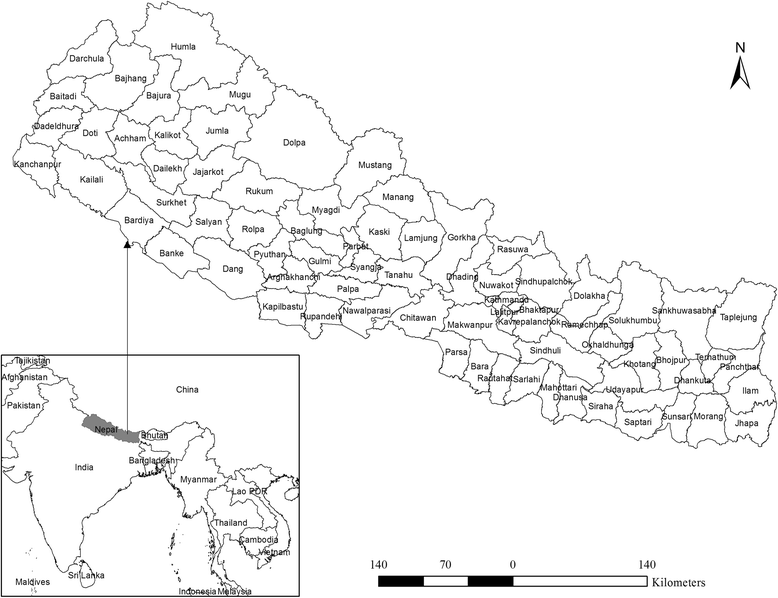
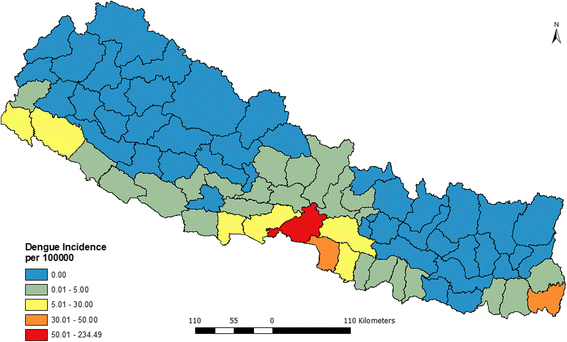
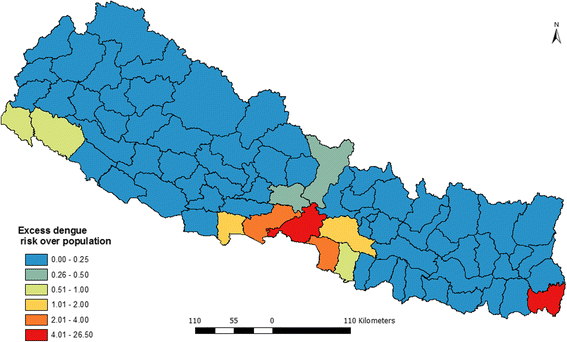
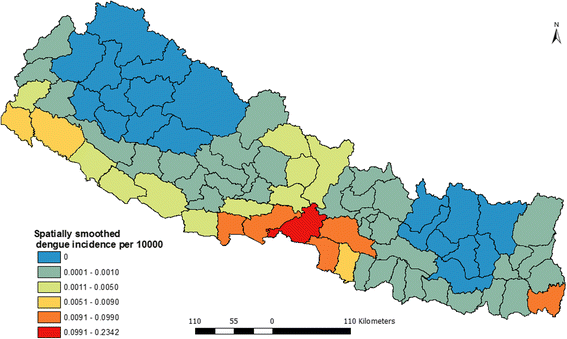
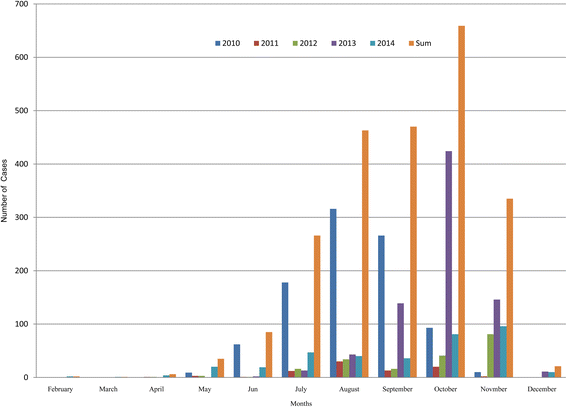
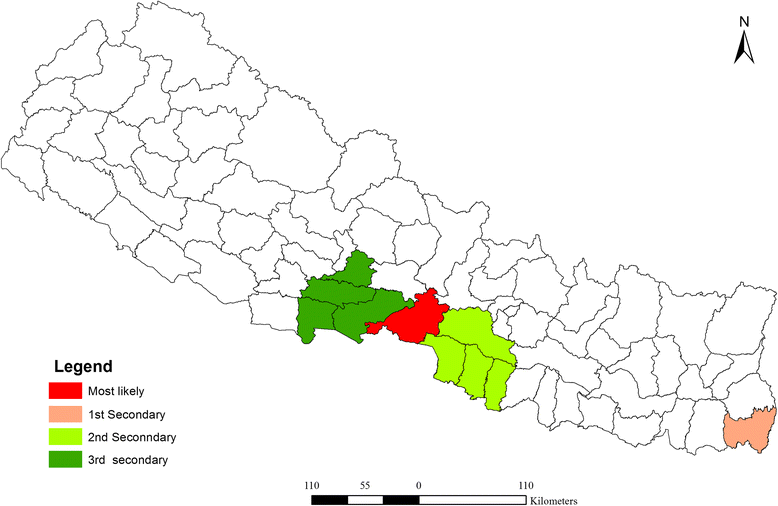
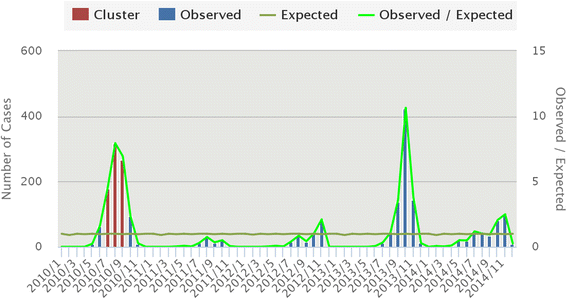
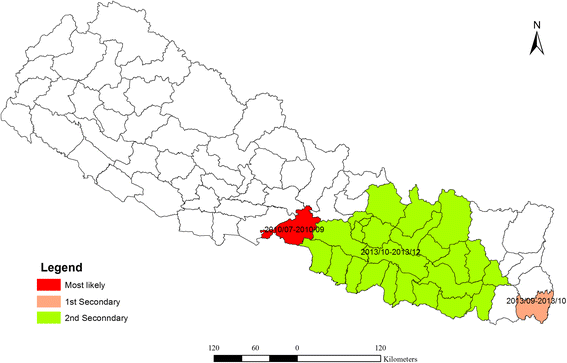
Similar articles
-
Modeling the spatially varying risk factors of dengue fever in Jhapa district, Nepal, using the semi-parametric geographically weighted regression model.Int J Biometeorol. 2018 Nov;62(11):1973-1986. doi: 10.1007/s00484-018-1601-8. Epub 2018 Sep 4. Int J Biometeorol. 2018. PMID: 30182200
-
Spatiotemporal Distribution and Geospatial Diffusion Patterns of 2013 Dengue Outbreak in Jhapa District, Nepal.Asia Pac J Public Health. 2018 May;30(4):396-405. doi: 10.1177/1010539518769809. Epub 2018 Apr 19. Asia Pac J Public Health. 2018. PMID: 29671332
-
Spatiotemporal analysis of dengue fever in Burkina Faso from 2016 to 2019.BMC Public Health. 2022 Mar 8;22(1):462. doi: 10.1186/s12889-022-12820-x. BMC Public Health. 2022. PMID: 35255865 Free PMC article.
-
Epidemiology of dengue in Nepal: History of incidence, current prevalence and strategies for future control.J Vector Borne Dis. 2016 Mar;53(1):1-7. J Vector Borne Dis. 2016. PMID: 27004572 Review.
-
Dengue periodic outbreaks and epidemiological trends in Nepal.Ann Clin Microbiol Antimicrob. 2018 Feb 23;17(1):6. doi: 10.1186/s12941-018-0258-9. Ann Clin Microbiol Antimicrob. 2018. PMID: 29471819 Free PMC article. Review.
Cited by
-
Spatiotemporal analysis of the dengue outbreak in Guangdong Province, China.BMC Infect Dis. 2019 Jun 4;19(1):493. doi: 10.1186/s12879-019-4015-2. BMC Infect Dis. 2019. PMID: 31164093 Free PMC article.
-
Increased thermal suitability elevates the risk of dengue transmission across the mid hills of Nepal.PLoS One. 2025 Apr 24;20(4):e0322031. doi: 10.1371/journal.pone.0322031. eCollection 2025. PLoS One. 2025. PMID: 40273130 Free PMC article.
-
Modeling the spatially varying risk factors of dengue fever in Jhapa district, Nepal, using the semi-parametric geographically weighted regression model.Int J Biometeorol. 2018 Nov;62(11):1973-1986. doi: 10.1007/s00484-018-1601-8. Epub 2018 Sep 4. Int J Biometeorol. 2018. PMID: 30182200
-
Microclimate factors related to dengue virus burden clusters in two endemic towns of Mexico.PLoS One. 2024 Jun 6;19(6):e0302025. doi: 10.1371/journal.pone.0302025. eCollection 2024. PLoS One. 2024. PMID: 38843173 Free PMC article.
-
Spatial autocorrelation of environmental factors influencing dengue outbreaks using Moran's I: A study from Nepal (2020-2023).PLoS One. 2025 Jun 4;20(6):e0324798. doi: 10.1371/journal.pone.0324798. eCollection 2025. PLoS One. 2025. PMID: 40465649 Free PMC article.
References
MeSH terms
LinkOut - more resources
Full Text Sources
Other Literature Sources
Medical
Miscellaneous

